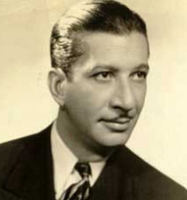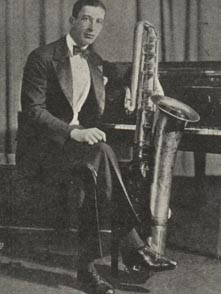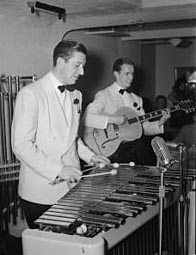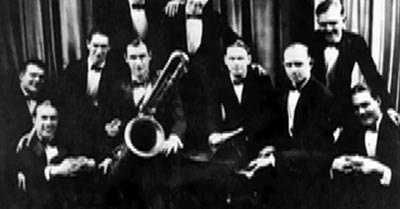
[Some computers might ask you to allow the music to play on this page]
Adrian Rollini |

I once heard the sound of Adrian Rollini's bass saxophone described as being like the sound of a great bear. Somehow, for me, Rollini's bass sax has been embedded in my jazz memories. The first time I heard it was in a 78 rpm recording of Bix Beiderbecke's 1927 Jazz Me Blues - everybody talks about Bix's cornet solo, but Rollini is ever there in the background and dropping in from time to time, adding colour and a taste of fun to the piece:
Unfortunately, I cannot play that track on this page, but you will find it on YouTube here.
Adrian Francis Rollini was born in New York to Italian parents on June 28th, 1903. He started taking piano lessons when he was just two and at the age of four, played a fifteen-minute recital at the Waldorf Astoria Hotel. Among the selections played were Chopin's Minute Waltz. Hailed as a child prodigy and was billed as "Professor Adrian Rollini." His brother, Arthur, was also a musician who played saxophone with Benny Goodman's Orchestra.
Adrian later recorded the Minute Waltz with his Trio and the number was filmed:

By age 14 Adrian was leading his own group of neighbourhood boys, playing both piano and xylophone. He left high school in his third year and started to cut piano rolls for the Aeolian company on their 'Mel-O-Dee' label, and the Republic brand in Philadelphia. At 16, he joined Arthur Hand's California Ramblers and by then was playing piano, drums, xylophone, and bass saxophone. When Hand retired, Rollinitook over the band.
During the 1920s, a number of classic recordings were issued by the California Ramblers and their subgroups - the Little Ramblers and the Goofus Five - and Adrian Rollini is thought to be the person who introduced the Goofus to jazz.. According to his brother in his book Thirty Years With The Big Bands, Adrian Rollini came home with a bass saxophone one day and in a week knew how to play it!
Listen to the Goofus Five playing Arkansas Blues from 1927. (Chelsea Quealey, trumpet; Bobby Davis, clarinet, soprano and alto sax; Sam Ruby, tenor sax; Adrian Rollini, goofus and bass sax; Irving Brodsky, piano; Tommy Fellini, banjo; Herb Weil, drums).
It is said that: 'It was during his work with these groups that he developed his distinctive style of saxophone playing. Rollini's swing and impetus are quite evident; "Clementine (From New Orleans)", "Vo-Do-Do-De-O Blues", and "And Then I Forget" are among some of the best recordings that not only typify the era but showcase the prominence and power that Rollini brought to the table. He was also recording with many other jazz bands at this time, including his playing with Bix.
Here's Clementine (From New Orleans) from 1927. The vocalist is Sadie Green (Beth Challis).
In the late 1920s, Adrian and other members of the Ramblers came to London to play in Fred Elizalde's band at the Savoy Ballroom.
Here he is playing If I Had You with Elizalde with Al Bowlly taking the vocals.
In 1928, Adrian Rollini returned to America where he began to write with Robbins Music Corporation, but he was continuing to play and record with the Dorsey Brothers, Jack Teagarden and others. In 1933, he formed the Adrian Rollini Orchestra (a studio group assembled for recording and which were clearly more commercial recordings), the Adrian Rollini Quintette, The Adrian Rollini Trio (primarily late 1930s) and Adrian and his Tap Room Gang.
Here's the Tap Room Gang playing Weather Man in 1935:
In this video clip, we can see Adrian Rollini briefly playing xylophone in The St Louis Blues. The clip is from 1937 and is of Richard Himber's orchestra. Himber who had played with Rudy Vallee's Connecticut Yankees, had one of the top "sweet" dancebands of the 1930s. (Quite a bit of background information comes with the video).
Rollini was beginning to play his vibraphone more and it is noted that Rollini recorded on bass sax for the last time in 1938. We read that he went on to play hotels, as well as arranging and writing songs behind the scenes, but he never did any big recording once the big band era really got underway, although he did take part in jam sessions.
Listen to Adrian Rollini's Quintet in 1938 playing Bei Mir Bist Du Schön (My Dear Mr Shane) with Bobby Hackett (trumpet), Frank Victor (guitar), Harry Clark (string bass), Buddy Rich (drums), Adrian Rollini (vibraphone) and - Sonny Schuyler (aka Sunny Skylar) vocals.
Adrian Rollini can be seen in a 1938 short entitled "For Auld Lang Syne" starring James Cagney, "Himber Harmonics" (1938) where  he appears with the trio, and "Melody Masters: Swing Style" (1939) - sadly, none of these appear to be available on Youtube.
he appears with the trio, and "Melody Masters: Swing Style" (1939) - sadly, none of these appear to be available on Youtube.
Adrian Rollini with Allen Haulon (guitar)
Adrian Rollini died on May 15, 1956, at the age of 52 and for a long time the circumstances of his death were somewhat of a mystery. According to the Melody Maker he was found lying in a blood-splattered car, and one of his feet was almost severed. The article also says he died of a heart attack and lung collapse. According to the book, Jazz and Death: Medical Profiles of Jazz Greats (2002), the author, M.D. Frederick J. Spencer (also a coroner) went back and analysed Rollini's death along with many other jazz greats, and discovered Rollini truly died of mercury poisoning. During his 18-day stay in hospital, he had developed a resistance to feeding and so a glass tube had been inserted into his stomach. The tube was weighted with mercury and somehow the tube broke, exposing Rollini to mercury poisoning.

In 1998, Adrian Rollini was inducted into the Big Band and Jazz Hall of Fame.
Here is Bill, the last recording Adrian Rollini made on bass sax. The song comes from the musical Showboat (Just My Bill). Buddy Rich is on drums again and Jackie Russin on piano.
Albert Haim, founder of the Bix Beiderbecke website writes: 'Thanks for providing information about Adrian Rollini. One addition: After the Goldkette band dissolved in the Fall of 1927, Adrian Rollini hired several Goldkette musicians (Bix, Tram, Rank, Murray) for his short-lived New Yorkers. The New Yorkers did not record under that name, but most musicians in the band got together under Trumbauer and recorded many sides. One correction: Rollini was in New York in 1928, briefly, when his dad died. Rollini returned permanently to New York in 1929.'
Albert's comprehensive website www.bixbeiderbecke.com is dedicated to the preservation and dissemination of information about Bix. Annotated lists of books, articles, video tapes, audio tapes, recordings, and related items are provided.
2017.2
Click here for details of other Jazz Remembered articles.
© Sandy Brown Jazz
Click HERE for our mailing list and we will email you when an update is made.